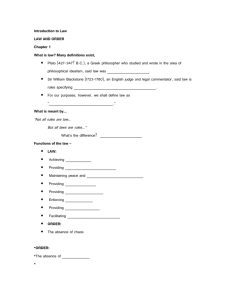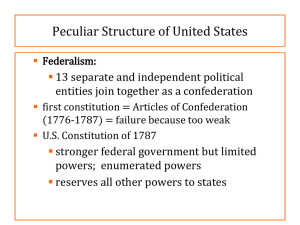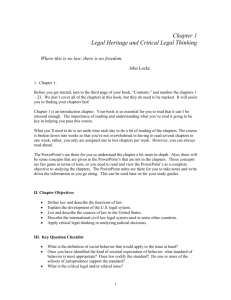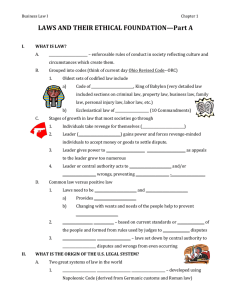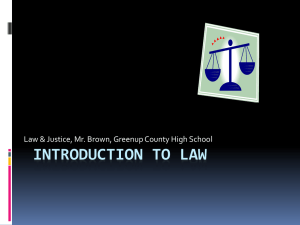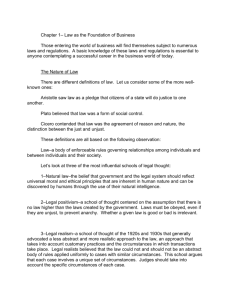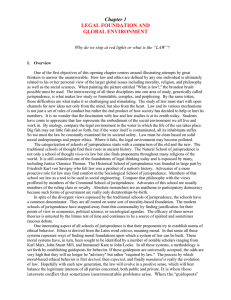Chapter 001 - Legal, Business, & E
advertisement
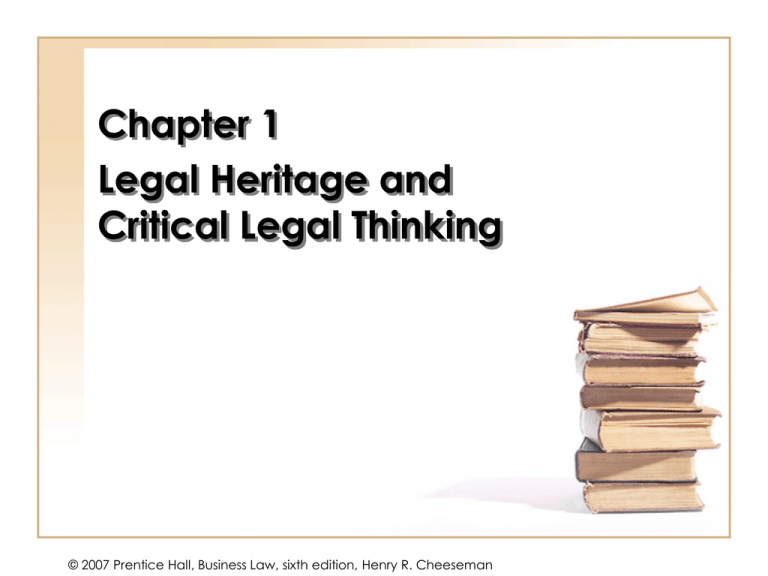
Chapter 1 Legal Heritage and Critical Legal Thinking Co © 2007 Prentice Hall, Business Law, sixth edition, Henry R. Cheeseman What is law? The law consists of rules that regulate the conduct of individuals, businesses, and other organizations within society. It is intended to protect persons and their property from unwanted interference from others. The law forbids persons from engaging in certain undesirable activities. 1-2 Definition of Law • A body of rules of action or conduct prescribed by the controlling authority, and having binding legal force. • That which must be obeyed and followed by citizens subject to sanctions or legal consequences. 1-3 Functions of Law • • • • • • • Keeping the peace Shaping moral standards Promoting social justice Maintaining the status quo Facilitating orderly change Facilitating planning Providing a basis for compromise • Maximizing individual freedom 1-4 Functions of Law (continued) • Facilitating planning – e.g., well-designed commercial laws allow businesses to plan their activities, allocate their resources, and assess their risks • Maximizing individual freedom – e.g., the rights of freedom of speech, religion, and association granted by the First Amendment to the U.S. Constitution 1-5 Qualities of the Law • Fairness of the Law – The American legal system is one of the most comprehensive, fair, and democratic systems of law ever developed and enforced. 1-6 Qualities of the Law (continued) • Flexibility of the Law – U.S. law evolves and changes along with the norms of society, technology, and the growth and expansion of commerce in the United States and the world. 1-7 Jurisprudence: The philosophy or science of the law. 1-8 Schools of Jurisprudential Thought Natural Law School Historical School Analytical School Sociological School Law and Economics School Critical Legal Studies School Command School 1-9 Schools of Jurisprudential Thought (continued) • Natural Law School – Postulates that law is based on what is “correct”. – Law should be based on morality and ethics. • Historical School – Believes that law is an aggregate of social traditions and customs. • Analytical School – Maintains that law is shaped by logic. 1 - 10 Schools of Jurisprudential Thought (continued) • Sociological School – Asserts that law is a means of achieving and advancing certain sociological goals. • Command School – Believes that law is a set of rules developed, communicated, and enforced by the ruling party. 1 - 11 Schools of Jurisprudential Thought (continued) • Critical Legal Studies School – Maintains that legal rules are unnecessary and that legal disputes should be solved by applying arbitrary rules based on fairness. • Law and Economics School – Believes that promoting market efficiency should be the central concern of legal decision making. 1 - 12 History of American Law • The English system of law was generally adopted • It became the foundation from which American judges developed our common law 1 - 13 English Common Law • Developed by judges who issued their opinions when deciding a case • The principles announced in these cases became precedent for later judges deciding similar cases. 1 - 14 English Common Law (continued) • English common law cases were decided by the: – Law Court • A uniform system of courts emphasizing form over substance • Granted only monetary damages – Court of Chancery (equity court ) • Sought when law courts could not grant appropriate remedy • Remedies were shaped to fit each situation 1 - 15 English Common Law (continued) – Merchant Court • Law Merchant rules based on common trade practices and trade 1 - 16 Adoption of English Common Law • U.S. courts usually permit plaintiffs to seek both legal and equitable orders and remedies • Merger of law, equity, and merchant court systems 1 - 17 The Civil Law System • Romano-Germanic civil law based on the Twelve Tables and the Corpus Juris Civilis • Napoleonic Code • German Civil Code 1 - 18 The Civil Law System (continued) • The Civil Code and parliamentary statutes that expand and interpret it are the sole sources of law in most civil law countries. • The adjudication of a case is simply the application of the code or the statutes to a particular set of facts. 1 - 19 In some civil law countries, court decisions do not have the force of law. 1 - 20 Adoption of English Common Law in America • All the states except Louisiana base their legal systems on the English common law. • Louisiana bases its law on the civil law. – Influence of its French heritage 1 - 21 Adoption of English Common Law in America (continued) • In the U.S., the law, equity, and merchant courts have been merged. – Most U.S. courts permit the aggrieved party to seek both law and equitable orders and remedies. 1 - 22 Sources of Law in the United States Constitutions Codified Law Treaties Executive Orders Judicial Decisions Agency Rules & Regulations 1 - 23 Sources of Law in the United States (continued) • Constitutions – The U.S. Constitution • establishes the federal government and enumerates its powers • Created three branches – Legislative – Executive – Judicial 1 - 24 Sources of Law in the United States (continued) – Powers not given to the federal government are reserved to the states. – State constitutions establish state governments and enumerate their powers. 1 - 25 Sources of Law in the United States (continued) • Treaties – The president, with the advice and consent of the Senate, may enter into treaties with foreign governments. 1 - 26 Sources of Law in the United States (continued) • Codified law: Statutes and ordinances – The U.S. Congress enacts federal statutes. – State legislatures enact state statutes. – Ordinances are enacted by municipalities and local government agencies. 1 - 27 Sources of Law in the United States (continued) • Executive orders – Issued by the president and state governors – Power derived from express delegation from legislative branch 1 - 28 Sources of Law in the United States (continued) • Regulations and Orders of Administrative Agencies – Administrative agencies are created by the legislative and executive branches of government. – They may adopt rules and regulations and may enforce and interpret statutes. 1 - 29 Sources of Law in the United States (continued) • Judicial decisions – Courts decide controversies. – Judicial decisions usually state the rationale used by the court in reaching that decision. 1 - 30 The Doctrine of Stare Decisis • Based on the common law tradition, past court decisions become precedent for deciding future cases. • Lower courts follow the precedent established by higher courts. 1 - 31 The Doctrine of Stare Decisis (continued) • Both federal and state courts follow the precedents established by U.S. Supreme Court decisions. • Courts in one jurisdiction are not bound by precedent of another jurisdiction, but may look at it for guidance . 1 - 32 Priority of Law in the United States • The U.S. Constitution and treaties take precedence over all other laws. • Federal statutes take precedence over federal regulations. • Valid federal law takes precedence over conflicting state or local law. 1 - 33 Priority of Law in the United States (continued) • State constitutions rank as the highest state law. • State statutes take precedence over state regulations. • Valid state law takes precedence over local laws. 1 - 34 Critical Legal Thinking • The process of: – specifying the issue presented by a case – identifying the key facts in the case and applicable law – applying the law to the facts – reaching a conclusion that answers the issue presented 1 - 35 Key Terms • Plaintiff • Defendant The party The party who against originally who the brought the lawsuit has lawsuit. been brought. 1 - 36 Key Terms (continued) • Petitioner or Appellant The party who has appealed the decision of the trial court or lower court. • Respondent or Appellee The party who must answer the petitioner’s appeal. 1 - 37
